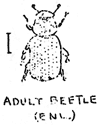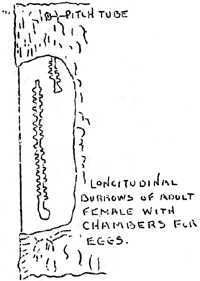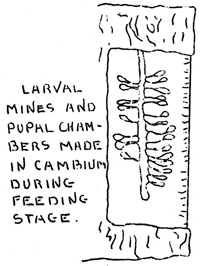Bobby Has Moved
By Earl U. Homuth
Bobby no longer inhabits the rock and wood pile near the lodge. He has taken up quarters near the Information Bureau on the Rim.
Bobby may be less conspicuous than Jemima or some of the Park bears, but certainly not less popular. The soft patter of his feet, scurrying across the floor of the Information Bureau may be the first announcement of his presence. A choice of raisins or crackers is immediately forthcoming from the ranger on duty.
His trusting nature, diminutive form, and the peculiar characteristic of a short bobbed tail by which he can be distinguished from others of the numerous golden mantled ground squirrels, endears him to visitors and rangers alike. Others of his kind may be just ground squirrels, but Bobby is a friend and pet of all.
He is certainly keeping Mrs. Bobby, and the family well supplied in a nest somewhere nearby.
Bugs!
By Earl U. Homuth
(This is the first of a series of articles dealing with the work of control or eradication of a bark beetle (Dendroctorius Monticolae, Hopk) which threatens to destroy the Pine forests of the park and surrounding areas. This, the Solar method of control, was developed in Crater Lake National Park, has passed the experimental stage, and will probably be introduced into other parks or areas where similar infection occurs. Materials for these articles, covering the various phases of the work, have been very kindly presented by Chief Ranger Godfrey, Park rangers, Stetson and F. Solinsky, Ranger Naturalist F. L. Wynd; and information on the life history is from the Park Manual of Information section on Forest Insects prepared by Mr. J. E. Patterson.)
Concerning the Control and Eradication of the Mountain Pine Beetle
By Godfrey, Stetson, Solinsky, Wynd, Patterson
A line drawn east and west through the center of Crater Lake National Park, has become of interest, not alone to the Park Service, but also to every forestry institution and person interested in the conservation of our forests. That line represents the encroaching outpost of a vast army of predatory insects which are destroying the forests of the Cascade Range.
North of this line lies an area of somewhat unfertile lands covering over 33,000 acres, in which practically the entire forest is dead, excepting a few stands of fir and of hemlock. The greatest percentage of the forest cover was lodgepole pines, and over 90% of these are destroyed, excepting, again, such trees as are less than six inches in diameter.
South of this line, is an intermediary section, covered with the same timber, two to three miles wide, in which the trees have been attacked.
Extending indefinitely southward, from this intermediary section, mixed with the deep forests of Mountain Hemlock and first, are the Western White Pine and Yellow Pines, the standing living forest of incalculable value, which is threatened by this invasion.
The infection appeared in the northern area about 1915 and since that time, as mentioned, has destroyed the entire stand of pines. Since 1920 this same insect has been developing in areas south of Crater Lake. The Park Service has expended considerable sums in an effort to destroy the beetle and preserve the forest.
In the spring of 1925 anxiety crystallized into action. Of the remaining pine forest stands, the entire timbered area of the park was threatened with destruction which seemed beyond control. The situation was brought before public and governmental attention and as a result, preliminary measure were begun largely with the object of finding what could be done to prevent the parasite from spreading into the Yellow Pines which covered the southern portion of the park, and which composed the most valuable timberland, both from a scenic and permanent standpoint. The efforts yielded little encouragement. The future held visions of another “silver forest”, gaunt skeletons of trees stripped in time of their bark; an area of desolation similar to that in the north, creating in the form of greater fire hazard, a menace to the new growth which might otherwise by natures plan conceal the desolation.
The insect causing this great destruction, the mountain pine beetle (Dendroctorius monticolae, Hopk) is about the size of a grain of wheat, cylindrical in shape and black in color.
The egg is very small, and pearl-white. The larva, full grown is also about the size of the adult, white, cylindrical, slightly curved and has a broad head; the pupa is almost of similar size; the newly formed young beetle is brown.
The beetle attacks many species of coniferous trees; in the park it attacks and kills the lodgepole pine, white pine, sugar, yellow and mountain white bark pine and the Engleman spruce. Larger and older trees are prefered, and the trunks and base of larger limbs of these although even saplings are attacked.
The fatal effect upon the tree is due to the life habits of the insect. The adult enters to the cambium, or living layer of the tree, by boring entrance holes through the outer bark. After entrance to the cambium layer, longitudinal galleries of some length are excavated on the surface of this sapwood, an in niches along the sides of these galleries the eggs are laid.
When the grub, or larva hatches, it feeds upon the cambium tissue, horizontally. The effect of the brood of one beetle might be negligible, but when many have entered, the tree is, by these many larvae feeding somewhere throughout its girth from just above ground to the largest branches, completely girdled in its very life tissue.
The season of activity of this beetle varies somewhat with elevations and climatic conditions. In Crater Lake National Park, the activity usually begins early in May and continues to September. Beetles which have wintered in trees begin to emerge in June, and this continues until August. New trees are of course attacked during this period and until late in August. The larvae hatch during early July, and continue to hatch and feed until late in September. With the advent of winter conditions, they become dormant in various stages of development, including some parent adults. Activity is resumed early in May. The parent adults lay eggs and these larvae, together with those which were dormant during the winter, feed until early June, when pupation takes place. The new adults emerge during July and August, thus completing the life cycle.
When an adult beetle enters a tree, the dust of its boring falls from the entrance holes and lodges in the bark crevices or is found upon the ground. Soon resin exudes from these holes, forming pitch tubes, which are very obvious and are unmistakeable signs of infestation.
The needles of the tree soon turn a yellowish white; and from two to eight months later, brick red. The tree is then dead, and partially dried out. By the end of July after the year of attack, the bark is marked by numerous circular holes, about 1/16 inch in diameter. These are the exit holes by which this new brood emerge from the tree. During the succeeding fall and winter, the needles fall from the tree; by the third year the bark starts to fall and soon the stark, bare trunk and limbs are exposed and the ghostly bleached trees form the “ghost forests” or “silver forests” found in various localities.




